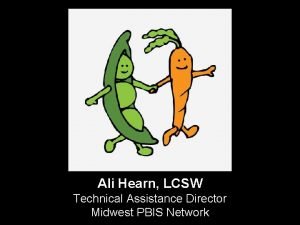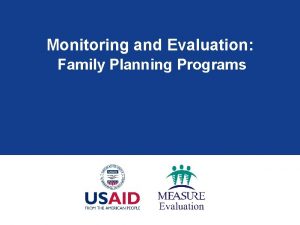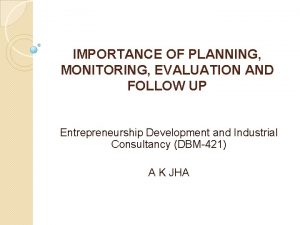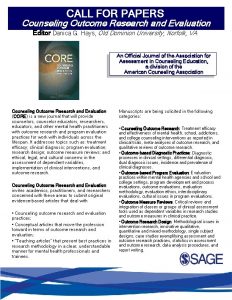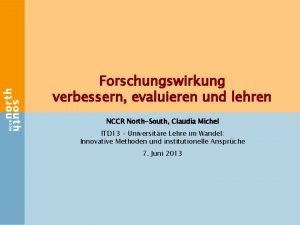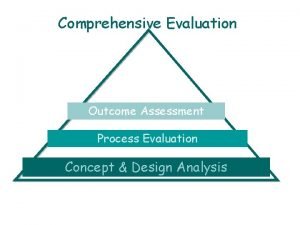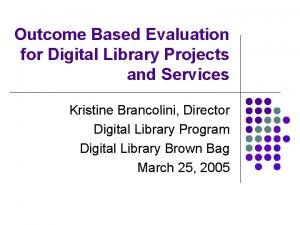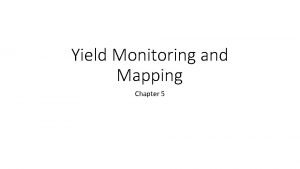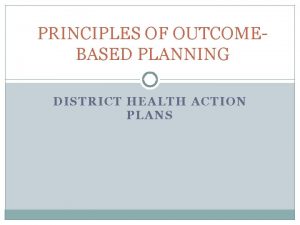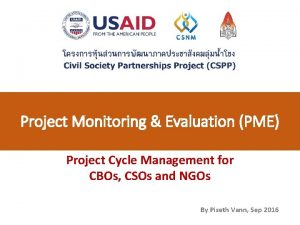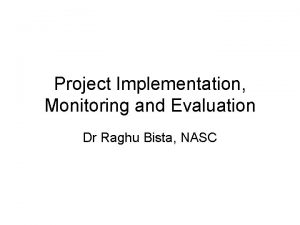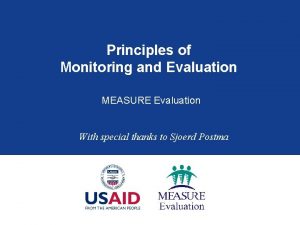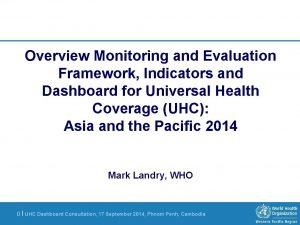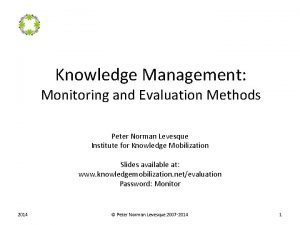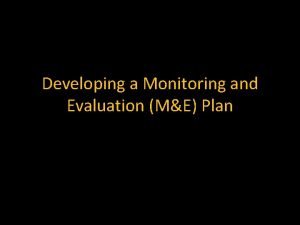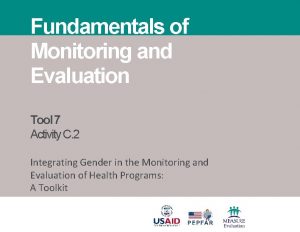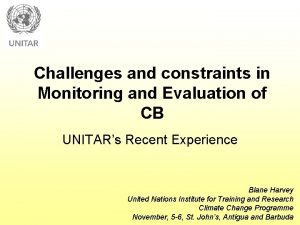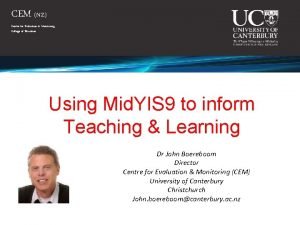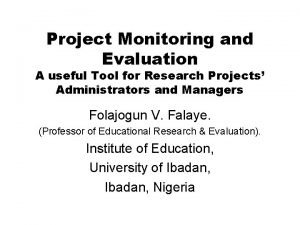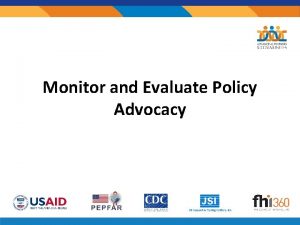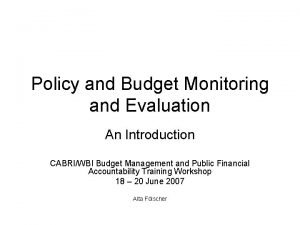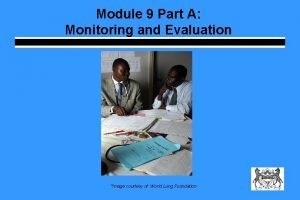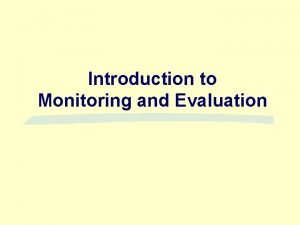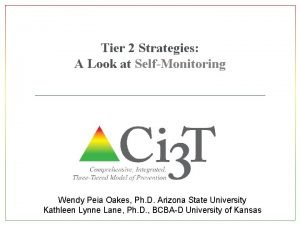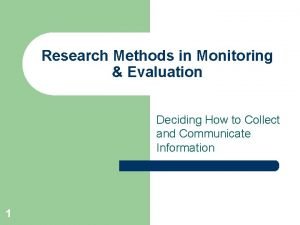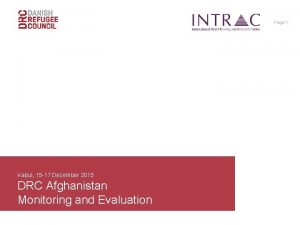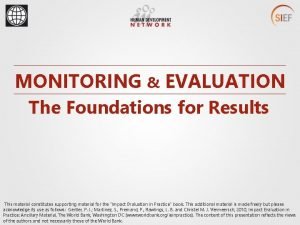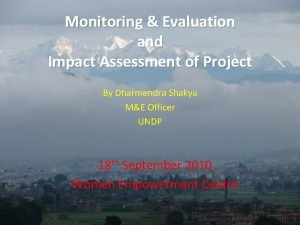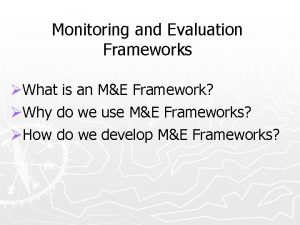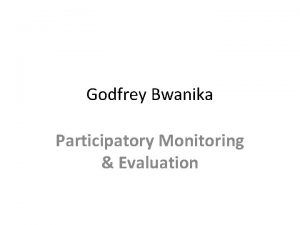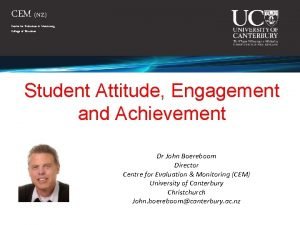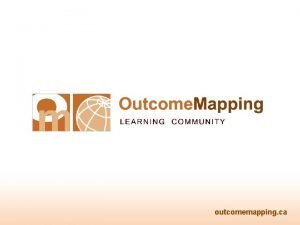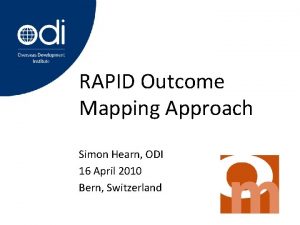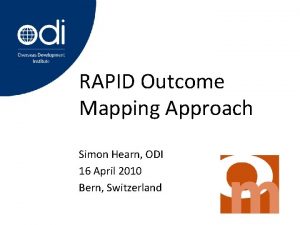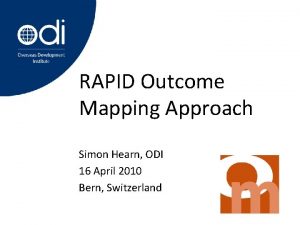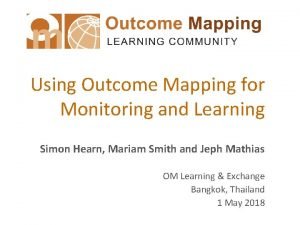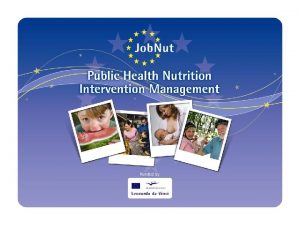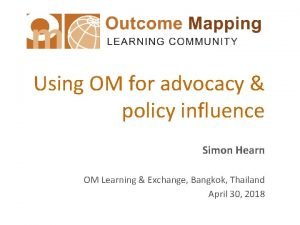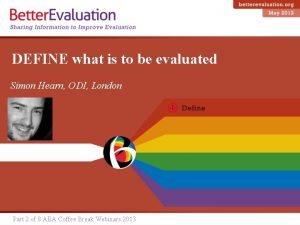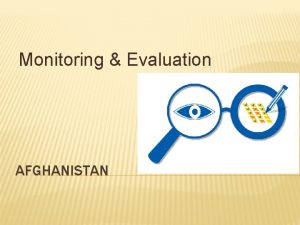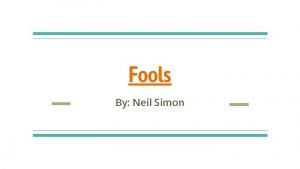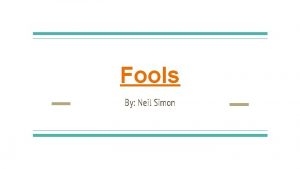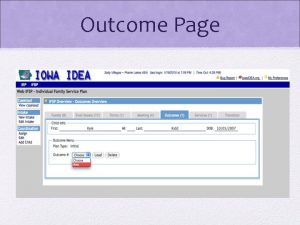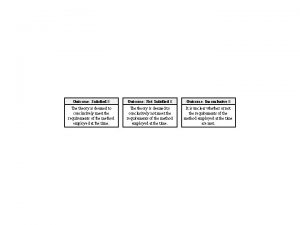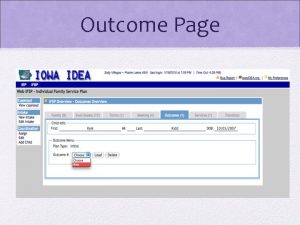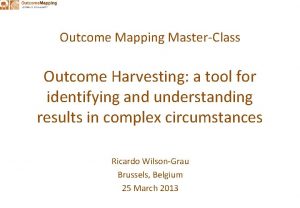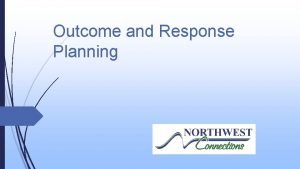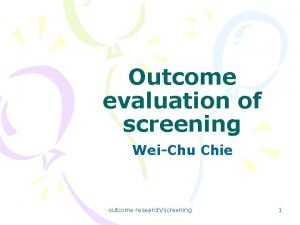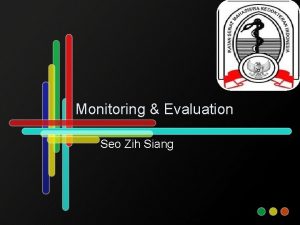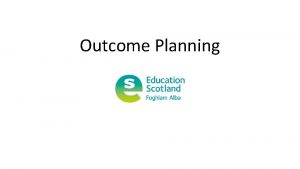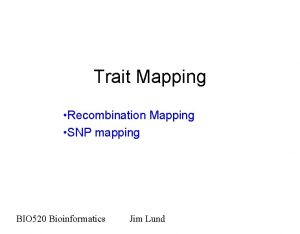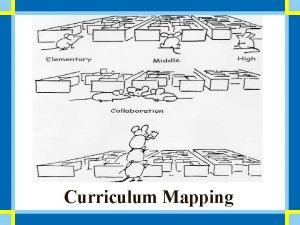Outcome Mapping Planning Monitoring and Evaluation Simon Hearn





































- Slides: 37

Outcome Mapping Planning, Monitoring and Evaluation Simon Hearn, Overseas Development Institute s. hearn@odi. org. uk www. outcomemapping. ca

Outline and aims 1. 2. 3. 4. Introduce principles of OM Give an overview of the steps Present an example of OM application Q&A

Acknowledgements This presentation makes use of various materials that were shared by members of the global OM community. Without being exhaustive, special thanks goes to Terry Smutylo, Steff Deprez, Jan Van Ongevalle, Robert Chipimbi, Daniel Roduner, Kaia Ambrose and many others.

Source: A guide for project M&E: IFAD

Social change can be… • Complex: • Unstable: involve a confluence of actors and factors independent of project duration • Non-linear: • Two-way: unexpected, emergent, discontinuous intervention may change • Beyond control: but subject to influence • Incremental, cumulative: watersheds & tipping points Source: Terry Smutylo

Challenges in evaluating in social change interventions 1. Establishing cause & effect in open systems 2. Measuring what did not happen 3. Reporting on emerging objectives 4. Justify continuing “successful” interventions 5. Timing – when to evaluate 6. Encouraging iterative learning among partners 7. Clarifying values 8. Working in ‘insecure’ situations Source: Terry Smutylo

Brief definition of OM • A participatory method for planning, monitoring and evaluation • Focused on changes in behaviour of those with whom the project or program works • Oriented towards social & organizational learning

OM: Brief history • 1990 s: post-Rio need to demonstrate ‘sustainable’ results • 1998: Barry Kibel and Outcome Engineering • 1999: Methodological collaboration with projects • 2000: Publication of manual in English • 2002: Training, facilitation & usage globally • 2006: OM Learning Community • 2008: CLAMA • 2010: East Africa and beyond


“The only real voyage of discovery exists, not in seeing new landscapes, but in having new eyes” Marcel Proust

Three key concepts in OM: 1. Sphere of influence 2. Boundary Partners 3. Outcomes understood as changes in behaviour

There is a limit to our influence Project Sphere of control Partners Sphere of influence Beneficiaries Sphere of interest

There is a limit to our influence Inputs, activities, outputs Sphere of control Outcomes: Changes in behavior Sphere of influence Impact: Changes in state Sphere of interest

Farmers participate in field trials Participating farmers learn how to use drip irrigation equipment Participatory research on demonstration farms to develop approaches to drip irrigation Extension workers visit demonstration farms Increased knowledge of techniques Farmers adopting drip irrigation methods Training of extension workers Publication of performance of different setups Reduced numbers of new wells Greater quantities of groundwater available Extension workers promoting drip irrigation Source: Terry Smutylo

Who are your boundary partners? Programme Beneficiaries Stakeholders Boundary Partners


The Problem with Impact implies… Cause & effect The reality is… Open system Positive, intended results Unexpected positive & negative results occur Focus on ultimate effects Upstream effects are important Credit goes to a single contributor Multiple actors create results & need credit Story ends when program Change process never obtains success ends Source: Terry Smutylo

Focus of Outcome Mapping Progr am in fluenc e ity n u m Com Inputs hip s r e own Activities decre ases ase e r c in s Outputs Outcome Mapping Impacts


4 Key Planning Questions Why? Vision Who? Boundary Partners What? Outcomes Challenges, Progress Markers How? Mission, Strategy Map, Organizational Practices

Step 1: Vision improved human, social, & environmental wellbeing

Step 2: Mission The mission is that “bite” of the vision statement on which the program is going to focus.

Step 3: Boundary Partners Those individuals, groups, & organizations with whom a program interacts directly to effect change & with whom the program can anticipate some opportunities for influence.

Step 4: Outcome Challenge • Describes behaviour of a single boundary partner • Sets out the ideal actions, relationships activities • Describes the boundary partner’s contribution to the vision

Step 5: Progress Markers Love to see (Deep transformation) Like to see (Active engagement) Expect to see (Early positive responses)

How can we measure. . . Greater awareness… Empowered women… Community ownership… Reduced conflict… Increased collaboration… Governmental commitment… Gender sensitivity… Equal access… Budgetary transparency… Active participation… Poverty alleviation… Strengthened capacity… ?

Step 6: Strategy Maps Causal I E Persuasive Supportive

Step 7: Organisational Practices 1. Prospecting for new ideas, opportunities, and resources 2. Seeking feedback from key informants 3. Obtaining the support of your next highest power 4. Assessing and (re)designing products, services, systems, and procedures 5. Checking up on those already served to add value 6. Sharing your best wisdom with the world 7. Experimenting to remain innovative 8. Engaging in organizational reflection

Five kinds of monitoring information Contextual Informat. Ion Program Partner State, status or situational data Strategies outcomes relevance & viability (behaviour changes in the (actions of the program) partners) implementation (interventions by the program)

Swayamsiddha Project • Context: Women in India are disempowered • Project: – Started in 2000, closed in 2005 – Funded by CIDA and IDRC – Managed by national NGO and local NGOs • Aims: – Develop network of government, non-governmental and community based organisations – Increase gender responsiveness in local health care, families and community institutions – Decreasing drudgery in women’s and girl’s work – Increase access to and control of financial services

Swayamsiddha Vision Across rural India, women and girls utilize and benefit from appropriate health care, education, food and water security and freedom from violence. Women have access to the markets, credit, banking and municipal services they need to pursue their livelihood goals. They use drudgery-reducing technologies and agricultural inputs that contribute to personal well-being and to ecological sustainability. Villages are fully served by public transport, are well lit at night and police enforce all laws fully and equitably. Girls attend school full time and families have the information and resources to make informed decisions regarding their health, safety and social needs. Gender equity governs household labor and decision-making; and men in the community understand support gender-responsive laws.

Swayamsiddha Mission The Swayamsiddha Project works with governments, NGOs & CBOs to improve women’s health and empowerment. It facilitates the development of women’s self help groups. It provides them with funding and training to help them influence community and government services to be more responsive to their health and livelihood needs. It fosters mutual respect and joint action between these self-help groups and: banks; police; health and social service providers; and government agencies. It researches and promotes the application of ecosystem approaches to human health in agriculture and in the provision of health and sanitation services. Swayamsiddha addresses equity issues in all its activities. It uses participatory methods to monitor progress, to learn how to become more effective in supporting its partners and to report on its results.

Families SHG PHCs Banks Police State NGO Community Leaders State NGO BAIF IDRC CIDA Swayamsiddha BPs State NGO

Outcome Challenge for SHG Women’s self help groups are taking action to make community and government services more responsive to the health and livelihood needs of women and girls. They influence banks, police, health and social service providers, local officials and state and national government agencies in relationships of mutual respect and joint action to improve women’s well being. Women’s self help groups arrange bank loans for members and for life skills training for girls to be included in the school curriculum. They influence local, state and national government policies and expenditures on community improvement and transportation and support women candidates to run for election to local government office.

Progress Markers for SHG • Expect to See Women’s Self Help Groups: – – – • Like to See Women’s Self Help Groups: – – – – • Holding meetings regularly Discussing a list of shared concerns Opening and contributing to a group bank account Acquiring skills in managing credit programs Soliciting training in maternal & child health for members from NGOs Forming grain banks Lending money to members to finance income generating activities Seeking ration cards from local authorities for needful women Arranging for immunizations by the public health clinic Lobbying police to close down illegal alcohol vendors Calling upon outside expertise to help identify drudgery-reducing technologies Pooling finances to purchase drudgery-reducing technologies Conducting maternal and child health education sessions for their communities Love to See Women’s Self Help Groups: – – – – Arranging bank loans for members Arranging for life skills training for girls to be included in school curriculum Lobbying local government for expenditures on community improvements Approaching the State Transport Dept for bus service to their villages Taking action responding to the incidence of violence in their community Lobbying national government depts. to invest in local development projects Putting forth candidates for election to local government council

Strategy Map Causal I Persuasive Supportive - Fund collection of monitoring data - Provide training in organizing and conducting group meetings - Take women’s photos - Training in needs identification sessions - Link SHG work to national for SHGs health program - Take women to banks to open accounts - Training sessions on dealing gov’t departments - Linking with active, successful SHGs in other communities - Exposure visits to income generating projects elsewhere - Conduct knowledge sessions on maternal and child health - Provide training in maintenance & repair of technologies E - Leadership training for local leaders - Provide training for health care - Conduct community info sessions on: workers violence, women’s rights, sustainable agriculture - Fund creation of Sanitation - Home visits to educate families Planning community-based group - Visit banks, discuss with, educate - Conduct training for PHCs on officials reproductive health - Training and placing researchers in the communities - Provide bicycles for girls - Bring in Water and Sanitation NGOs to conduct water purification demonstrations - Conduct community forums on SHGs - Information sessions on new technologies (chullha stoves, growing fuel woods, toilets, agricultural tools for women, well repair) - Link PHCs to others delivering gender-based services - Initiate regular Parent/Teacher group meetings

vision mission Banks Women’s Self Help Groups BAIF State NGOs Girls & Women Police Families Community Leaders Public Health Clinics Strategies Strategic Partners 37 Boundary Partners Project’s Outcomes BP’s outcomes Source: Terry Smutylo
 Ali hearn
Ali hearn Monitoring and evaluation of family planning programs
Monitoring and evaluation of family planning programs Importance of planning, monitoring and evaluation
Importance of planning, monitoring and evaluation Counseling outcome research and evaluation
Counseling outcome research and evaluation Nccr north south
Nccr north south Outcome evaluation
Outcome evaluation Outcome based evaluation
Outcome based evaluation What is visitor pre registration in picme
What is visitor pre registration in picme Yield monitor data
Yield monitor data Simons and chabris 1999
Simons and chabris 1999 Outcome based planning definition
Outcome based planning definition The associative mapping is costlier than direct mapping.
The associative mapping is costlier than direct mapping. Forward mapping vs backward mapping
Forward mapping vs backward mapping Terjemahan
Terjemahan Monitoring cycle in project management
Monitoring cycle in project management Comparison between monitoring and evaluation
Comparison between monitoring and evaluation Principles of monitoring
Principles of monitoring Monitoring and evaluation dashboard
Monitoring and evaluation dashboard Knowledge management monitoring and evaluation
Knowledge management monitoring and evaluation M & e plan template
M & e plan template Principles of monitoring and evaluation
Principles of monitoring and evaluation Basics of monitoring and evaluation
Basics of monitoring and evaluation Monitoring and evaluation challenges
Monitoring and evaluation challenges Centre for evaluation and monitoring
Centre for evaluation and monitoring Tools for project monitoring and evaluation
Tools for project monitoring and evaluation Advocacy process 8 steps
Advocacy process 8 steps Budget monitoring and evaluation
Budget monitoring and evaluation Monitoring and evaluation image
Monitoring and evaluation image Introduction to monitoring and evaluation
Introduction to monitoring and evaluation Monitoring and evaluation tool sample deped
Monitoring and evaluation tool sample deped Research methods in monitoring and evaluation
Research methods in monitoring and evaluation Example of monitoring and evaluation in project proposal
Example of monitoring and evaluation in project proposal Difference between monitoring and evaluation
Difference between monitoring and evaluation Monitoring and evaluation plan sample
Monitoring and evaluation plan sample Me framework
Me framework School monitoring, evaluation and plan adjustment sample
School monitoring, evaluation and plan adjustment sample Annual implementation plan
Annual implementation plan Centre for assessment and monitoring
Centre for assessment and monitoring
